What does honeysuckle look like and how to grow honeysuckle?
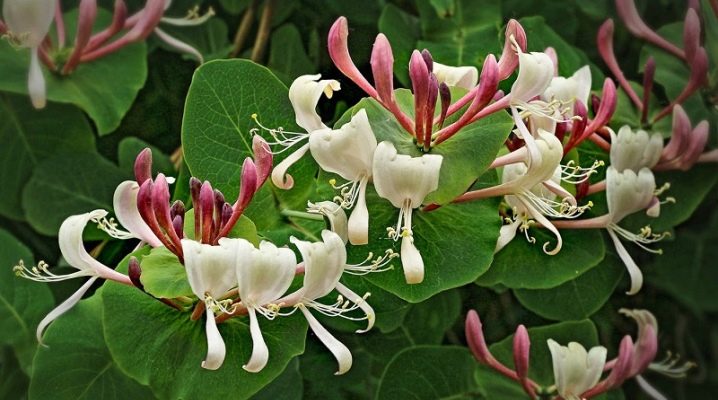
On a new site or on an old one, but in need of "renovation", plants are often selected to solve two problems at once. In order to green the territory as much as possible (to green - literally), and to decorate it. And also, so that the plant is not problematic. Honeysuckle is suitable for such a role - honeysuckle, as beautiful as it is practical on the site.
general description
This honeysuckle forms (and rather quickly) a vine, which is capable of covering unremarkable species on the site: some kind of deformed section of the fence, not a very beautiful part of the building. She is able to twine around any support, bloom profusely and spread a special scent. And there is only one snag in the cultivation of fragrant honeysuckle - the plant is thermophilic, the cold can ruin it.
The people call this culture "goat honeysuckle" or simply "goat leaf". In a natural environment, such a shrub can be found in the Caucasus, in the south of Europe. Liana is a perennial, it can grow up to 6 m in length. It grows rather quickly, and can reach its growth limit in 5 years. And she blooms in the fourth year of growth. In total, the liana lives for about half a century, that is, the planting is definitely profitable.
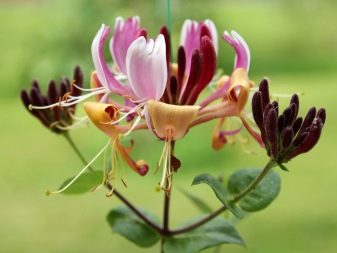

Description of the plant:
- honeysuckle has thin shoots, very flexible, have a light green color with a pinkish undertone;
- the shoots become lignified over time, the bark will begin to flake off, and a mosaic-type pattern will turn out (which is absolutely normal for honeysuckle, this is not a disease);
- the leaves of honeysuckle are oval, paired, with a bright green front side and a dull red, or even bluish, back;
- it blooms in May-June, and its flowers are in the form of tubules, which grow in "bunches" with a diameter of about 10 cm;
- the plant has long stamens, protruding significantly outward;
- petals can be bright yellow, white, pink, scarlet, blue and lilac;
- the flower lives only 2-3 days, but new ones will not be long in coming, therefore continuous flowering will last for about a month;
- blooming honeysuckle is an amazing aroma, and by the evening it becomes even richer;
- The aroma of the plant is not just pleasant, it works as a therapy - it helps to calm down, it can be useful to sit on a bench near such a vine before going to bed.
And this type of honeysuckle is considered a good honey plant.... After flowering on the bushes, fruits will be tied, small berries of a shade close to coral. They are collected in several pieces, these berries are definitely not edible. But such a plant is decorative to the same extent as during the flowering period (if not even more beautiful). The characteristic of curly honeysuckle will be strange, if the minuses of the plant are not indicated at all. They, of course, are: you will have to control its growth and reproduction, otherwise the honeysuckle simply occupies the entire site. And then it will be comparable to a weed.
As already noted, honeysuckle is thermophilic, in some regions the plant is threatened with freezing. Well, problems can arise with a vine transplant, it often dies after this procedure.
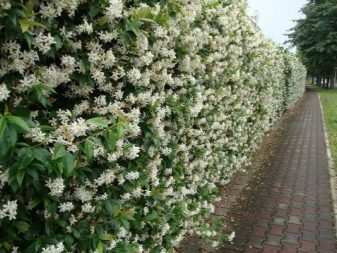
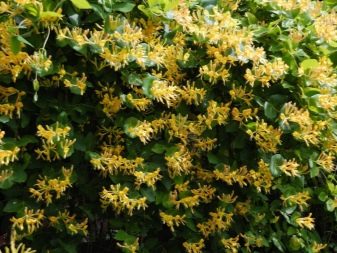
Popular varieties
One of the most beautiful varieties of honeysuckle - "Small-flowered". This is a pale red bush with a small number of flowers, but it looks aristocratic and graceful on the site. A little inferior to him grade "Alba", honeysuckle of early flowering, its flowers are blue or white.
Among other interesting varieties - "Inga" (beautiful capitate inflorescences, can be of different colors), "Telman" - yellow flowers with a moderate aroma, on the bushes they look like lights, "Harlequin"- light pink flowers, also with not the brightest aroma, Belgica Select - pink or purple flowers, red fruits and flowering twice a year. And you can also pay attention to the variety Graham Thomas with long flowers, white and yellow, bloom for a long time.
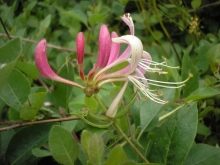
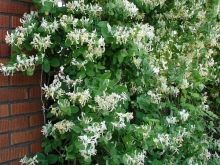
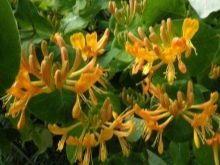
Landing
In the garden, the honeysuckle should be placed in a quiet and warm position. A climbing plant definitely needs a support, it can be a coarse mesh, a pergola, a gazebo or a lattice against the wall... If it is decided to plant a vine against the wall, it will need a solar wall, because then the flowering will be truly abundant. The plant will be uncomfortable where there is stagnant water. He will not like dry sandy soils, as well as heavy loams.
Where honeysuckle is good:
- on neutral or slightly alkaline soil;
- on damp soil (but not wet, you need to feel the difference);
- in the land where the humus content is high, because this also affects the abundance of flowering.
Again, the ground near the wall will be dryish, therefore, if the vine is planted there, it will need frequent watering.
Here's how to plant honeysuckle.
- It can be bought at the garden market where it is sold as a container plant. And such seedlings can be planted throughout the growing season (however, taking into account the planting zone and the onset of the first autumn frosts).
- In the fall, you should not plant honeysuckle, yet this culture lacks frost resistance. Therefore, it is better to plant it in the spring. Such a plant will need abundant watering. It is better to disembark on a cloudy day, right after the rain.
- A hole is dug, if the landing is near the wall, the hole is dug 40 (on average) centimeters from it. If the vine decorates the fence, the plant is planted at a meter distance.
- The earth needs to be well dug up, loosened, peat, rotted manure or compost added to it. This will improve the moisture holding capacity of the soil.
- Before planting a shrub, you need to install supports - the honeysuckle will rise on them, and this is important to prevent stress on the roots.
- Seedlings are sent to the pit. They should sit in it 5-10 cm deeper than they were buried in the pots. The soil needs to be compacted, watered.
- After that, the shoots must be carefully tied to the support.
- The ground around the bush needs to be covered with bark, this will not allow moisture to evaporate so quickly.
The landing itself is not difficult, where follow-up care is more important.
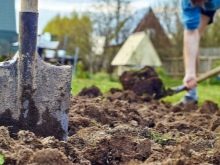
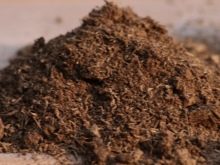
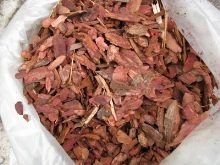
Care
It is, as is customary, complex, that is, by deleting one of the components of care, you can deprive the plant of something important that determines its growth and development.
Watering
It is especially important in the summer, during the period of fruit formation. It can even be called decisive in successful fruiting. If at the same time it is hot, dry, a lot depends on watering.
It is better to water the honeysuckle less often, but at the same time organize abundant watering, because it is important to reach deep soil layers with water.
Top dressing
It grows quickly, and such crops are usually in dire need of feeding. Every spring, the soil around the bush is loosened, mixed with compost (it must be crushed) or rotted manure. In the absence of organic matter, you can also use mineral fertilizing, exactly the one that is intended for flowering plants. These are usually preparations in the form of granules, which must be dispersed at the beginning of the growing season, as well as at the intersection of spring and summer.
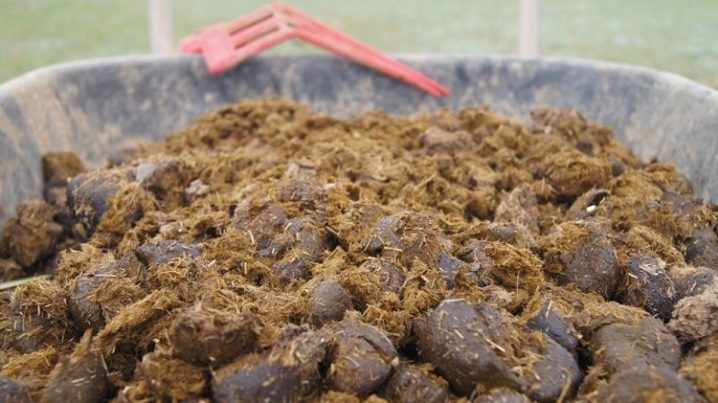
Loosening and weeding
Honeysuckle will not get along with neighbors, it cannot be called a friendly plant. Therefore, before planting, it is imperative to remove all weeds from this area of the site.... As the bush grows, the soil will also have to be weeded. Because clean and loosened soil receives oxygen and heat.
If the soil is not mulched, weeding should be organized about once every 2 weeks.
Pruning
In the process of growing a seedling, you need to concentrate on the three main shoots, the rest simply break off. The honeysuckle going up in height needs to be trimmed. In order for the honeysuckle to grow in breadth, this is necessary.And the hedge won't form because of this. Expansion implies falling of the lower leaves, "bald spots" appear. And to disguise them, you will have to plant another loach bush, which will cover unsightly places with young leaves.
With regular pruning of a climbing plant, it will increase its growth rate, give beautiful and bright flowers, and form unusual fruits. And without pruning, this will be impossible to achieve. After wintering, it is necessary to cut off weak shoots, that is, to make sanitary pruning.
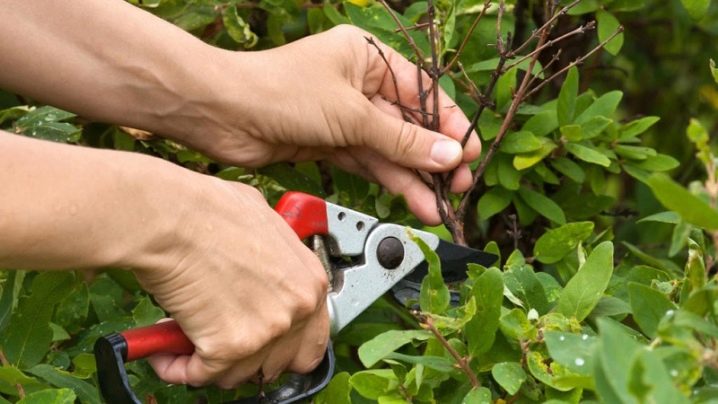
Preparing for winter
The trunk circle will have to be cleared of debris, and then covered with a thick leafy layer, not less than 20 cm. Instead of dead leaves, you can also use straw. Then shoots are removed from the support, folded into a ring, covered with spruce branches from above, covered with burlap or something similar. But due to the useless frost resistance and in this form, the shoots run the risk of freezing, because in the spring they will have to be cut off. If the climate is warm, it is possible not to cover the honeysuckle, if the plant is cultivated in cold regions (in Siberia, for example, although this is very rare), cover is necessary.
Even in the southern regions, in the first year after transplanting, the plant can be covered: it is not about winter hardiness, but about the vulnerability of the culture.
Reproduction
Seeds, cuttings, layering - these are 3 ways that you can propagate a vine. But the first method is completely unpopular, because the germination of honeysuckle is very weak. You can try: collect seeds from ripe berries, rinse and dry. Stratification is indispensable - the seeds are usually mixed with sand, poured into a container and sent to the refrigerator until the beginning of spring... The soil must be sprayed regularly. Then the seeds are sent to not very deep containers, where humus, sand and peat are mixed (there is twice as much peat as other ingredients). The soil must be slightly moistened, and then with the help of a film, create a greenhouse, without removing it until the shoots appear. And you can plant seeds directly into the ground, but the germination rate will be even lower. The seedlings of honeysuckle will go to a permanent place next spring, at which time they should reach 30 cm.
Propagation by cuttings is a method in which materials are harvested in July. You need to take old shoots that break well. Shoots are cut into cuttings of 10 cm, and each has 2 or 3 buds. You only need to leave 2 top leaves, which are cut by half. The bottom cut will be diagonal. For 3 hours, the cuttings are soaked in a product that stimulates the formation of the root system. They are planted in a greenhouse, the interval is on average 20 cm (it is necessary to deepen by a third).
Well, the method with layering is popular due to its simplicity: in April, the shoot bends to the ground, fits into a trench 5 cm deep. The bark is incised by 2 mm, in this position it is fixed, sprinkled with humus. This place needs more watering, and so all summer, at the end of which sprouts appear (if everything went well). Then the seedling is safely separated from the mother culture, transplanted in the spring to a permanent place.


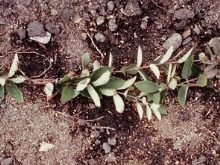
Diseases and pests
A caterpillar can attack the honeysuckle leaf roll: it will suck the juice out of the leaves, they will curl up into a tube, dry up and fall off. If honeysuckle attacks scabbard, it will also suck the juices out of the honeysuckle, causing the plant to wither. Aphid liana attacks immediately in colonies and will also feed on its juices. To avoid the attack of such pests, the loach needs spray every 2 weeks with infusions with a pungent odor: with pine needles, citrus fruits, garlic or onions. And also insecticides will help in the fight - "Aktara", "Fufanon" and analogues.
Among the diseases on the sad list of leaders will be powdery mildew, rust and moniliosis. To prevent these ailments, at the start and end of the growing season, both the honeysuckle and the soil are treated with a fungicide solution. When diagnosing the disease, all affected leaves must be removed.Usually climbing honeysuckle gets sick if it does not have enough light, if watering is very frequent or, conversely, extremely rare. And she is also afraid of cold drafts and depleted land on her site. So she will not live up to the average duration of her life.
With a well-chosen planting site, proper care, a plant with bright flowers (from deep pink to dark orange), alternating with unusual berries, will appear on the site. It is beautiful, aromatic and original!
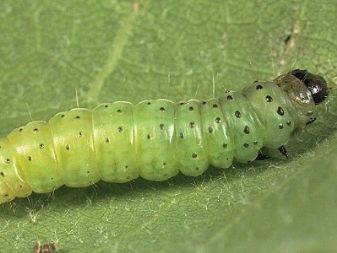
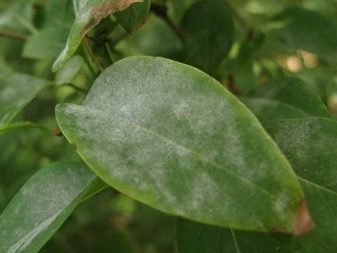








The comment was sent successfully.